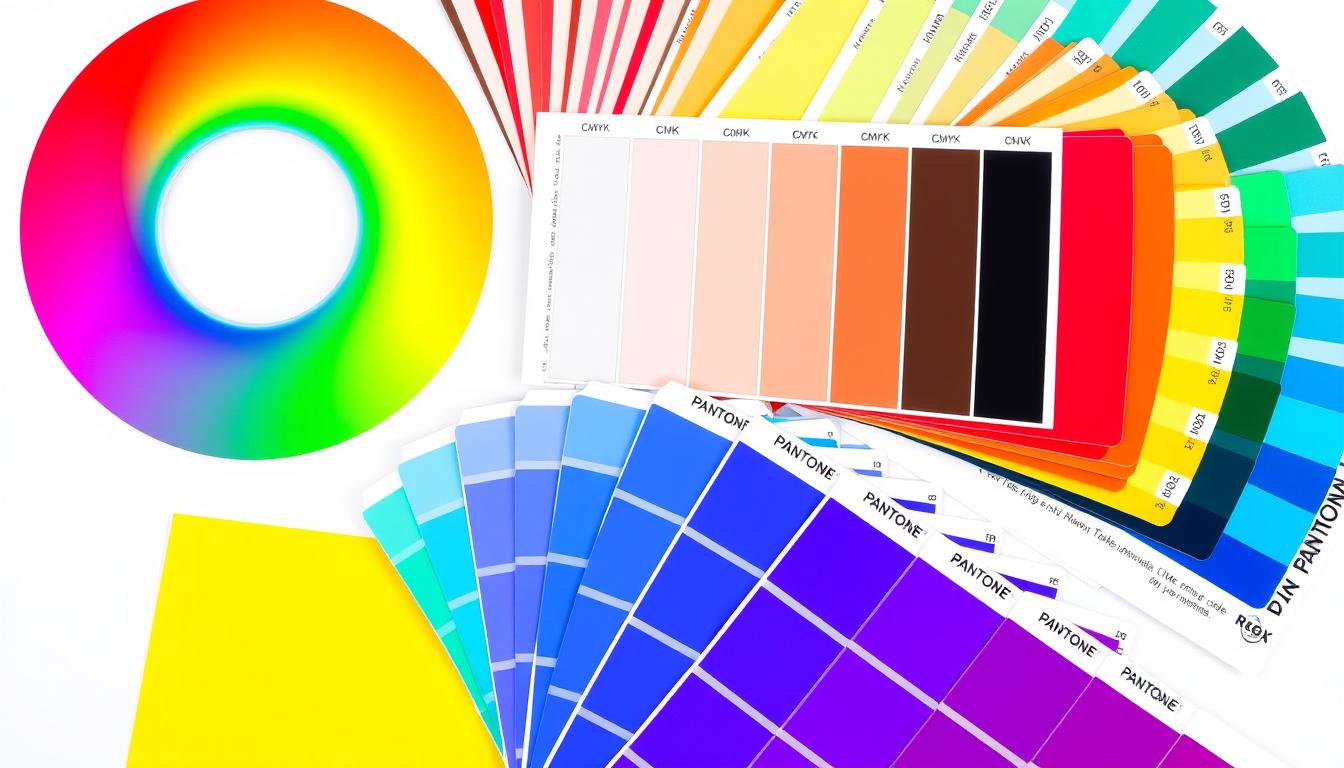RGB vs CMYK vs PMS: Decoding Design Color Terms
In the world of design, knowing about color is key. RGB, CMYK, and PMS are terms that often confuse clients and designers. These color models are vital for getting colors right across different platforms and mediums. RGB, or Red, Green, and Blue, is for digital screens like computers and phones. It’s how colors show up on our screens. CMYK, or Cyan, Magenta, Yellow, and Black, is for printing. The Pantone Matching System (PMS) is like the “Haute Couture of Colors.” It gives each color a unique number for exact color matching, especially in branding and logos. It’s important for designers, printers, and clients to know about these color models. This ensures that the final product, like a website or brochure, looks as intended. It helps keep the brand’s visual identity consistent. Key Takeaways: RGB, CMYK, and PMS are the three primary color models used in design and printing. RGB is the color model for digital displays, while CMYK is the standard for printing. PMS provides a precise color matching system, making it popular for branding and logo design. Knowing when to use each color model is essential for achieving accurate color representation across different platforms. Consistent color management is crucial for maintaining brand identity and visual consistency. Understanding Color Models: Digital vs Print The color model you pick can really change how your design looks. RGB is for digital, and CMYK is for print. Knowing how each works is key to getting colors right everywhere. RGB: The Digital Dynamo RGB is the heart of digital design. It mixes red, green, and blue light to show bright colors on screens. This makes it perfect for digital stuff like websites and ads. RGB color profile consists of Red, Green, and Blue hues that combine to create extensive variations of colors and exists exclusively in screen displays like computer monitors and mobile screens. RGB color profile uses additive processes to produce colors by blending light and provides a larger gamut than CMYK. Adobe Illustrator shows how RGB colors mix to make different shades. It’s great for creating eye-catching designs. CMYK and PMS: Print Perfection For print, CMYK and Pantone Matching System (PMS) are the go-tos. CMYK mixes cyan, magenta, yellow, and black inks to print colors. CMYK color profile contains Cyan, Magenta, Yellow, and Black that combine to produce a range of hues and is used for printed designs like business cards, flyers, posters, and packaging. PMS is for matching colors exactly, which is great for brands. It is advised to set documents to CMYK before printing to prevent color inconsistencies between RGB and CMYK equivalents. “Understanding the differences between these color models is crucial for ensuring consistent and accurate color reproduction across digital and print platforms.” Mastering RGB: The Red, Green, Blue Trio The RGB color model is at the core of digital design. It’s key for web design and digital art. This “additive” color system mixes red, green, and blue to create many colors. In RGB, each color has a value from 0 to 255. A higher value means a brighter color. Mixing all colors at 255 gives us white. Without any, we get black. This system is vital for web-safe colors. It helps colors look the same on different digital platforms. By understanding RGB, designers can make their rgb color, web design, and digital design projects pop. They use color theory to grab their audience’s attention. “The RGB color model is the foundation of the digital world, allowing designers to create a symphony of colors that captivate the senses and leave a lasting impression.” Knowing RGB is essential for digital designers. It helps them make bright, eye-catching digital experiences. With this knowledge, designers can explore new creative paths and improve their web design and digital design work. Cracking the CMYK Code: Cyan, Magenta, Yellow, Black In the world of print design, the CMYK color model is key. It stands for Cyan, Magenta, Yellow, and Black. This “subtractive” color system creates a wide range of colors by layering these four primary colors. CMYK Color Representation The CMYK color model mixes different percentages of the four ink colors. When all four are combined, they make a deep black. But, adjusting each color lets designers create a wide range of print design options, from soft pastels to bright colors. The Difference Between Black and Rich Black CMYK printing uses a single “key” (black) ink. But, there’s a big difference between regular black and “rich black.” Regular black uses 100% black (K) ink. Rich black combines all four CMYK colors, making a deeper, richer black. Knowing the CMYK color model and the difference between black and rich black is vital. It helps designers manage cmyk color in the print design world. By understanding these, designers can make sure their colors look great in all printed materials. Unveiling the Pantone Matching System (PMS) In the world of print design, the Pantone Matching System (PMS) is key. It ensures colors are precise, helping designers keep colors consistent everywhere. This is crucial for matching colors across different platforms and mediums. The Haute Couture of Colors The PMS is like the “haute couture” of colors. It offers a wide range of pre-mixed, opaque inks for “spot colors.” This means designers can use metallic and fluorescent shades that CMYK can’t match. Pantone’s focus on color excellence makes it vital for branding and packaging where exact color matching is a must. Pantone Color Bridge: Bridging the Digital-Print Gap The Pantone Color Bridge is a vital tool for designers. It connects digital and print colors, ensuring colors on screens match those on paper. This avoids costly color mistakes and keeps designs consistent. Thanks to the Pantone Matching System and the Color Bridge, designers can work confidently with colors. They can ensure their pantone matching system, spot color, print design, branding, and color consistency are perfect from start to finish. “Pantone colors are the haute couture of the design world, offering unparalleled precision and a vast array of options that elevate … Read more


